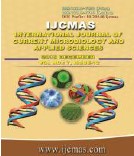


 National Academy of Agricultural Sciences (NAAS)
National Academy of Agricultural Sciences (NAAS)

|
PRINT ISSN : 2319-7692
Online ISSN : 2319-7706 Issues : 12 per year Publisher : Excellent Publishers Email : editorijcmas@gmail.com / submit@ijcmas.com Editor-in-chief: Dr.M.Prakash Index Copernicus ICV 2018: 95.39 NAAS RATING 2020: 5.38 |
A long-term field experiment was conducted to design and implement alternative production systems with increased resource use efficiency, productivity and to determine the effect of tillage systems and mineral fertilizers on soil organic carbon patterns. This experiment intended to evaluate the effects of these management strategies on soil structural formation and structural stabilization of a sandy loam soil. The shift from puddled - transplanted rice on the flat land to raised bed systems affects the productivity and resource use efficiency of the rice-wheat system. Therefore, the potential benefits and constraints of tillage crop residue practices need to be quantified on short to long-term basis, optimum layouts and management systems to maximize yield and efficiency. Due to lesser energy input and higher output T3 ZT with 6tha-1residue retained had 20% and 5% higher energy use efficiency than T7 CT and T6 PRB with 6tha-1residue retained. Undisturbed soil samples were collected from the 15 to 100 cm soil layer in the field grown with wheat to assess SOC, bulk density, C restoration rate, C sequestered, C sequestration efficiency (%) and crop yield. However, at the end of the 18 years period, SOC was 25% greater with T6 than T7, 16% greater with T4 than T1, and 17% higher with T2 than T7. Average SOC concentration of the control treatment was 0.54%, which increased to 0.65% in the RDF treatment and 0.82% in the RDF+FYM treatment and increased enzyme activities, which potentially influence soil nutrients dynamics under field condition. Compared to F1 control treatment the RDF+FYM treatment sequestered 0.28 Mg C ha-1 yr-1 whereas the NPK treatment sequestered 0.13 Mg C ha-1 yr-1. As tillage intensity increased there was a redistribution of SOC in the profile, but it occurred only between ZT and PRB since under CT, SOC stock decreased even below the plow layer. Increased SOC stock in the surface 50 kg m-2 under ZT and PRB was compensated by greater SOC stocks in the 50-200 and 200-400 kg m-2 interval under residue retained, but SOC stocks under CT were consistently lower in the surface 400 kg m-2. Over the last 18 years, CT lost 0.83 ±0.2 kg of C m-2 while ZT gain 1.98 ±0.3 and PRB gain 0.97 ±0.2 kg of C m-2 in the 1200 kg of soil m-2 profile. These findings suggest that carbon sequestration can be improved if treatments T4 or T6 are used in lieu of T7, respectively.
 |
 |
 |
 |
 |